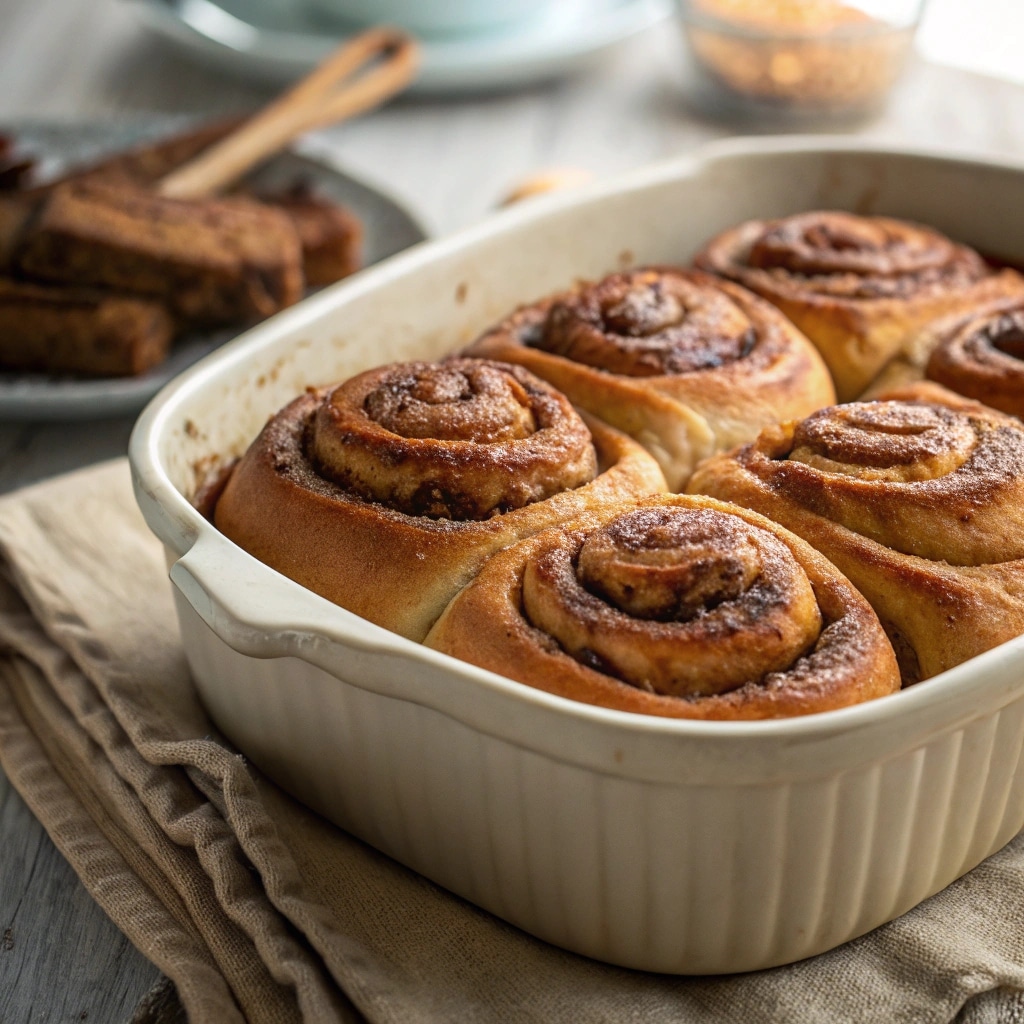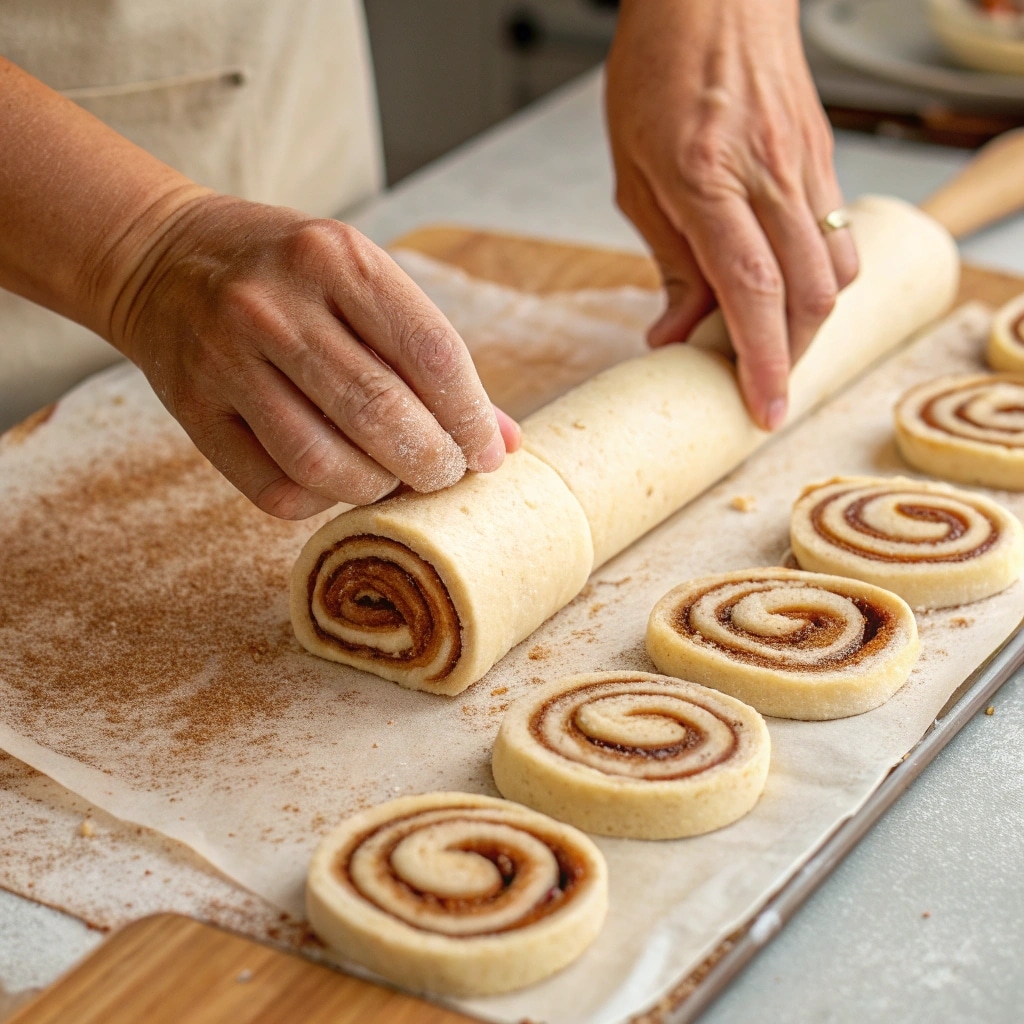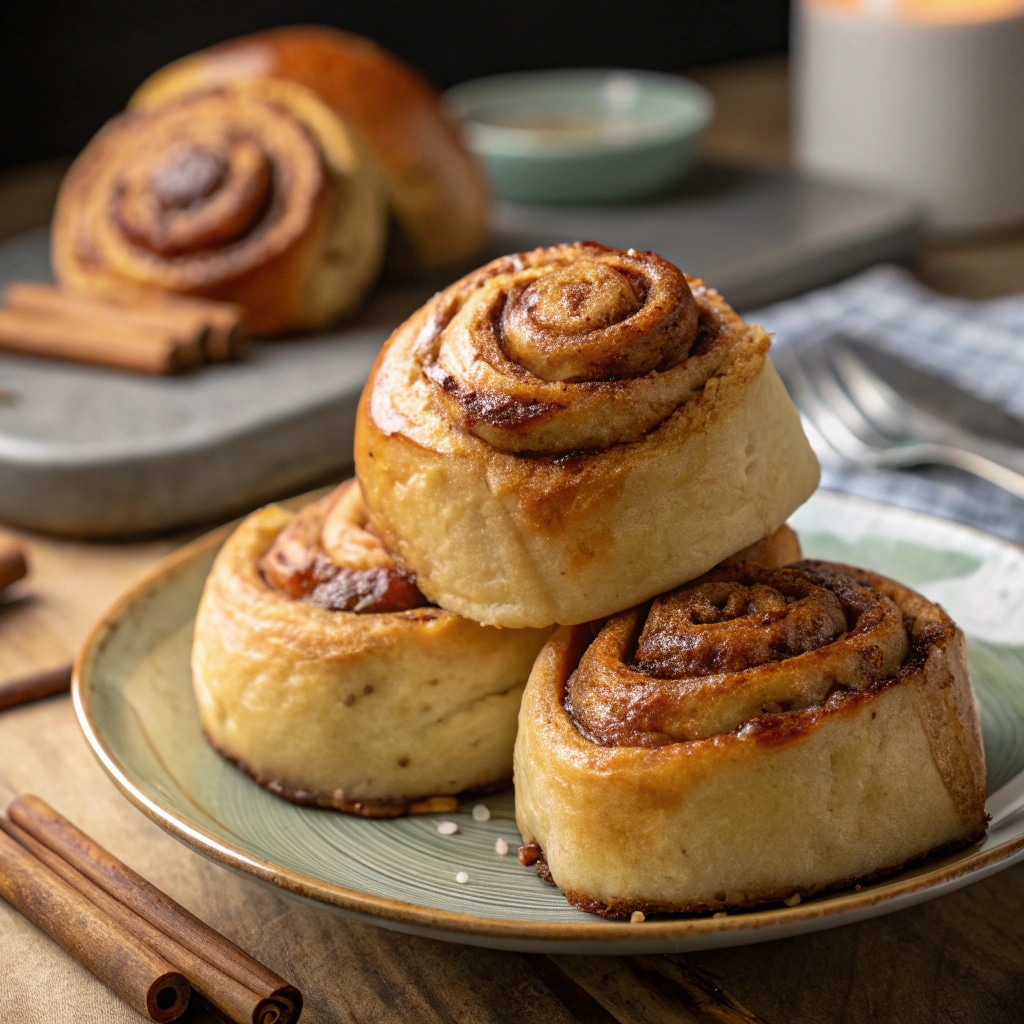My love for sourdough cinnamon rolls started on a chilly Asheville morning when I was experimenting with my starter after baking a sourdough baguette. Instead of another loaf, I decided to roll the dough out, slather it with butter, cinnamon, and sugar, and see what happened. What came out of the oven that day changed how I thought about cinnamon rolls forever. The tang from the sourdough starter balanced the sweetness, creating layers of flavor you simply don’t get from a packet of yeast.

Over the years, I’ve learned there’s no single way to enjoy them. Some days, I reach for easy sourdough cinnamon rolls that come together quickly with a long overnight rise. Other weekends, I’ll pull out my most enriched sourdough dough, the kind that uses eggs and butter, for a decadent brioche-style version. And if you’re still learning, don’t worry—understanding the basics of feeding your sourdough starter will set you up for success.
In this guide, I’ll share how to make overnight sourdough cinnamon rolls, classic cream cheese-topped rolls, and rich brioche rolls that melt in your mouth. No matter which you choose, each one brings that cozy, homemade touch I’ve always loved.
Table of Contents
What Makes Sourdough Cinnamon Rolls Unique?
I’ll never forget the first time I shared sourdough cinnamon rolls with my family. I had been baking regular cinnamon rolls for years, but when I swapped commercial yeast for my sourdough starter, something magical happened. The rolls came out soft and layered, with just the slightest tang that made the cinnamon-sugar swirl taste even sweeter. My husband took one bite and said, “These aren’t just cinnamon rolls—they’re better.” That’s when I knew I was hooked.
The difference between sourdough and regular cinnamon rolls really comes down to fermentation. With sourdough, you’re not rushing the dough; you’re giving it time. That slow rise lets natural yeast and bacteria work together, creating a pillowy crumb with depth of flavor you can’t fake. This is why I always tell new bakers curious about whether sourdough bread is gluten free that it’s not just about nutrition—it’s about the flavor journey that long fermentation creates.
For me, the best part is how flexible sourdough can be. On busy weekdays, I’ll shape overnight sourdough cinnamon rolls and let the fridge do the work. But when I want to celebrate, I reach for enriched sourdough cinnamon rolls—the kind that remind me of brioche, buttery and indulgent. Once you’ve tasted that balance of tang and sweet, you’ll understand why bakers like us keep coming back.
Ingredients Needed for Perfect Sourdough Cinnamon Rolls
When I first started making sourdough cinnamon rolls, I measured loosely and often ended up with inconsistent results. Once I began paying attention to the balance of ingredients, my rolls went from dense to melt-in-your-mouth soft. Here’s the lineup I rely on when making easy sourdough cinnamon rolls or a richer brioche-style version:
- 500 g (about 4 cups) bread flour – provides the structure that keeps the rolls tall and fluffy.
- 100 g (about ¾ cup) all-purpose flour – softens the dough, keeping it tender.
- 200 g active sourdough starter (100% hydration) – brings that tangy flavor and natural rise you need for overnight sourdough cinnamon rolls.
- 250 g whole milk (about 1 cup) – enriches the dough and helps create a pillowy crumb.
- 2 large eggs – add richness and structure, especially in enriched sourdough cinnamon rolls.
- 80 g unsalted butter (about 6 tablespoons), softened – gives flavor and that brioche-like softness.
- 75 g granulated sugar (about ⅓ cup) – sweetens the dough and helps caramelization.
- 10 g salt (about 2 teaspoons) – balances the sweetness and deepens flavor.
- For the filling: 100 g brown sugar (about ½ cup), 2 tablespoons ground cinnamon, plus 50 g butter (about 4 tablespoons) softened for spreading.
Over the years, I’ve swapped maple syrup for sugar, added a pinch of cardamom with the cinnamon, and even stirred a bit of orange zest into the filling, these little twists make the rolls feel uniquely mine.
Preparing Your Sourdough Starter for Cinnamon Rolls
I’ve ruined enough batches of sourdough cinnamon rolls to know this: a strong starter is non-negotiable. When I finally started treating my starter like the heart of the bake, everything changed. Here’s the step-by-step way I prepare mine before mixing dough:
- Feed the starter the night before – I give it equal parts flour and water by weight. For example, 100 g starter, 100 g flour, 100 g water. By morning, it’s bubbly, doubled, and smells sweetly tangy.
- Check the rise – A healthy starter should at least double in volume within 4–6 hours of feeding. I mark the jar with a rubber band so I can actually see the growth.
- Perform the float test – Drop a spoonful into water. If it floats, the starter is airy and strong enough for enriched dough. If it sinks, it needs more time.
- Keep it warm – I’ve learned my culture thrives best around 75–78°F. Too cold, and fermentation drags; too hot, and it collapses.
- Avoid common mistakes – I’ve made them all: using cold starter straight from the fridge, forgetting to feed it enough, or letting it over-ferment until sour and sluggish. Each one left me with dense rolls that never truly rose.
- Trust the signs – Once the starter is active, bubbly, and passes all the checks, I know it’s ready to carry my dough through long fermentation and give me the soft, layered crumb I want in overnight sourdough cinnamon rolls.
Following these steps consistently has made my starter reliable. Instead of guessing, I can trust it to lift my dough every time—and that’s the kind of baking confidence you build batch by batch.
Step-by-Step Recipe for Sourdough Cinnamon Rolls
Making sourdough cinnamon rolls follows a sequence of steps that balances structure, flavor, and tenderness. This process works well whether the goal is easy overnight rolls or rich, brioche-style spirals.
- Mix the dough – Combine active sourdough starter, warm milk, eggs, sugar, and softened butter. Add flour and salt, stirring until a sticky dough forms. Avoid adding too much extra flour at this stage.
- Knead for strength – Knead until the dough becomes smooth and elastic, usually 8–10 minutes by hand or slightly less with a mixer. A well-developed dough should stretch without tearing.
- Bulk fermentation – Transfer to a greased bowl, cover, and let rise until nearly doubled. This stage typically takes 4–6 hours depending on room temperature. Occasional stretch-and-folds help build gluten strength.
- Prepare the filling – While the dough rests, mix brown sugar with cinnamon. Keep softened butter ready for spreading. This preparation ensures an even swirl later.
- Roll out the dough – Once fermentation is complete, roll into a rectangle on a floured surface. Spread butter evenly across the dough, then sprinkle the cinnamon-sugar mixture.
- Shape the rolls – Roll tightly from the long side into a log, then cut into even pieces. Dental floss works well for clean cuts.

- Final proof – Arrange rolls in a greased pan, cover, and let rise until puffy. For overnight sourdough cinnamon rolls, refrigerate at this stage and bake the next morning.
- Bake – Place in a preheated oven and bake until golden brown and fragrant. The result is soft, layered rolls with balanced tang and sweetness.
This method creates consistency. After several bakes, I found that following each step closely eliminates guesswork and produces rolls that are fluffy, flavorful, and beautifully layered every time.
Print
Sourdough Cinnamon Rolls
- Total Time: 12 hrs (including proofing)
- Yield: 12 rolls 1x
- Diet: Vegetarian
Description
Soft and fluffy sourdough cinnamon rolls with a tangy-sweet flavor. Includes three methods: overnight discard, classic cream cheese, and rich brioche-style.
Ingredients
- 500 g bread flour
- 100 g all-purpose flour
- 200 g sourdough starter
- 250 g warm milk
- 2 large eggs
- 80 g unsalted butter
- 75 g sugar
- 10 g salt
- Filling: 100 g brown sugar, 2 tbsp cinnamon, 50 g butter
- Optional Cream Cheese Frosting: 120 g cream cheese, 60 g butter, 100 g powdered sugar, 1 tsp vanilla
Instructions
1. Mix starter, milk, eggs, sugar, butter, flour, and salt into dough.
2. Knead until smooth and elastic.
3. Bulk ferment until doubled with stretch-and-folds.
4. Roll out dough, spread butter, sprinkle cinnamon sugar.
5. Roll into log, slice evenly, arrange in greased pan.
6. Proof until puffy or refrigerate overnight.
7. Bake at 375°F until golden brown.
8. Frost or glaze as desired.
Notes
Overnight version: Use discard and refrigerate overnight. Brioche version: Increase butter and sugar for a richer dough.
- Prep Time: 30 mins
- Cook Time: 30 mins
- Category: Bread, Dessert
- Method: Baking
- Cuisine: American
Nutrition
- Serving Size: 1 roll
- Calories: 290
- Sugar: 14g
- Sodium: 210mg
- Fat: 9g
- Saturated Fat: 5g
- Unsaturated Fat: 3g
- Trans Fat: 0g
- Carbohydrates: 45g
- Fiber: 2g
- Protein: 6g
- Cholesterol: 45mg
2 Ways to Make Sourdough Cinnamon Rolls
All three variations share a common dough base, with small adjustments for sweetness, richness, or convenience. Below is the core recipe, followed by tailored instructions for each method.
Core Dough Ingredients (for all versions)
- 200 g sourdough starter (active or discard, depending on recipe)
- 250 g warm milk
- 2 large eggs (omit for discard version)
- 60–100 g butter (softened or melted, depending on recipe)
- 75–100 g sugar
- 500–550 g flour (bread or all-purpose, depending on recipe)
- 8–10 g salt
Filling (all versions)
- 50–60 g softened butter
- 100–150 g brown sugar
- 1–2 tablespoons ground cinnamon
Optional Frosting (classic version)
- 120 g cream cheese
- 60 g butter
- 100 g powdered sugar
- 1 teaspoon vanilla extract
Classic Sourdough Cinnamon Rolls with Cream Cheese Frosting
- Use active starter.
- Use bread flour (500 g) for stronger structure.
- Keep butter at 60 g and sugar at 75 g.
Instructions
- Mix starter, milk, eggs, sugar, butter, flour, and salt. Knead until smooth.
- Bulk ferment 4–6 hours with stretch-and-folds.
- Roll, fill, shape, and cut into 10–12 rolls. Proof 2 hours until puffy.
- Bake at 375°F (190°C) for 30–35 minutes.
- Spread cream cheese frosting over warm rolls.

Brioche-Style Sourdough Cinnamon Rolls
- Use active starter.
- Increase butter to 100 g and sugar to 100 g.
- Use bread flour (550 g) for a rich, structured dough.
Instructions
- Mix starter, milk, eggs, sugar, butter, flour, and salt. Knead 10–12 minutes until silky.
- Bulk ferment 5–6 hours or refrigerate overnight.
- Roll, fill, shape into 12 rolls, and proof until doubled.
- Bake at 375°F (190°C) for 30–35 minutes.

Icing and Toppings for Sourdough Cinnamon Rolls
The finishing touch can make sourdough cinnamon rolls unforgettable. Whether you prefer something classic, dairy-free, or a creative twist, these topping ideas add flavor and personality.
Classic Cream Cheese Frosting
Ingredients
- 120 g cream cheese, softened
- 60 g unsalted butter, softened
- 100 g powdered sugar
- 1 teaspoon vanilla extract
Instructions
- Beat cream cheese and butter until smooth.
- Add powdered sugar and vanilla; mix until creamy.
- Spread over warm rolls for a tangy-sweet finish.
Dairy-Free or Vegan Alternative
Ingredients
- 100 g vegan cream cheese or coconut cream
- 50 g plant-based butter
- 90 g powdered sugar
- ½ teaspoon vanilla extract
Instructions
- Whisk vegan cream cheese and butter until fluffy.
- Add powdered sugar and vanilla. Adjust sweetness to taste.
- Spread lightly to keep rolls airy and balanced.
Creative Glazes and Nut Toppings
Ingredients
- 80 g powdered sugar
- 2–3 tablespoons liquid (maple syrup, citrus juice, or milk of choice)
- Optional: chopped pecans, walnuts, or candied nuts
Instructions
- Stir powdered sugar with chosen liquid until smooth and pourable.
- Drizzle glaze over rolls.
- Sprinkle with nuts for added crunch and flavor.
With these options, every batch can feel different: tangy and rich, light and dairy-free, or playful with seasonal glazes.
Troubleshooting Common Issues
Even experienced bakers run into hiccups with sourdough cinnamon rolls. Here are the most common problems and how to fix them.
Why Are My Sourdough Cinnamon Rolls Dense?
- Cause: Starter wasn’t active enough or dough was underproofed.
- Fix: Always check starter readiness (bubbly and doubled after feeding). Extend proofing time until rolls look puffy and airy.
How to Fix Under-Proofed or Over-Proofed Dough
- Under-proofed: Rolls bake tight and chewy. Let dough rest longer—up to an extra hour—before baking.
- Over-proofed: Dough collapses and spreads out. If caught early, gently reshape and proof for a shorter time. For advanced cases, use over-proofed dough as discard in pancakes or waffles.
What to Do If Rolls Bake Unevenly
- Cause: Uneven shaping or hot spots in the oven.
- Fix: Slice rolls evenly, place them snugly in the pan, and rotate halfway through baking. For ovens with strong hot spots, an oven thermometer helps regulate accuracy.
With a little practice, these challenges become part of the learning curve. Each mistake teaches you how sourdough behaves, and every correction gets you closer to soft, golden, perfectly risen rolls.
Storing and Freezing Sourdough Cinnamon Rolls
Sourdough cinnamon rolls taste best fresh from the oven, but with the right storage, they can be just as good the next day—or even weeks later.
Best Storage Methods for Freshness
- Keep cooled rolls in an airtight container at room temperature for up to 2 days.
- For longer storage, refrigerate up to 5 days, though texture is slightly firmer.
- Always let rolls cool completely before storing to avoid sogginess.
Freezing and Reheating Tips
- Freeze baked, unfrosted rolls in a sealed freezer bag or container for up to 2 months.
- To serve, thaw at room temperature, then warm at 300°F (150°C) for 10–12 minutes.
- For unbaked rolls: shape, freeze individually on a tray, then transfer to a container. Thaw overnight in the fridge before baking.
Making Ahead for Holidays
- Prepare dough and shape rolls the day before. Cover tightly and refrigerate overnight.
- On baking day, allow 1–2 hours at room temperature to finish proofing.
- For large gatherings, par-bake rolls until lightly golden, then cool and freeze. Reheat fully before icing.
With these storage methods, sourdough cinnamon rolls can be enjoyed fresh, reheated, or even prepared weeks ahead for stress-free holiday mornings.
FAQ’s
Can I make these without a sourdough starter?
Yes. If you don’t have a starter, substitute with commercial yeast. Use 7 g (one packet) of instant yeast, and reduce proofing times significantly. The flavor won’t have the tangy depth of sourdough cinnamon rolls, but the texture will still be soft and fluffy.
Is active starter required for overnight rolls?
Not always. Overnight sourdough cinnamon rolls can be made with active starter for natural fermentation, or with discard plus baking powder for convenience. If you want maximum rise and a lighter crumb, use an active, bubbly starter.
How do I keep rolls from being dense?
Dense rolls usually mean the starter wasn’t strong enough or the dough was underproofed. Always feed your starter ahead of baking and allow plenty of time for bulk fermentation and final proofing. A simple float test helps confirm readiness before mixing.
Can I use frozen starter for brioche rolls?
Frozen starter won’t work directly. Thaw and revive it with several feedings at room temperature before baking. Brioche-style sourdough cinnamon rolls rely on a very active culture to lift the heavy, enriched dough, so a sluggish starter will struggle.
Final Thoughts
Sourdough cinnamon rolls prove that time and care create unmatched flavor. Whether you choose the ease of overnight rolls, the classic cream cheese version, or indulgent brioche spirals, each variation delivers that perfect mix of tang and sweetness. Start with a healthy starter, trust the fermentation, and enjoy the process—every batch is a chance to bake something warm, soft, and memorable.
Follow me on Facebook and Pinterest where I share cozy, easy-to-make baking recipes just like this one.
